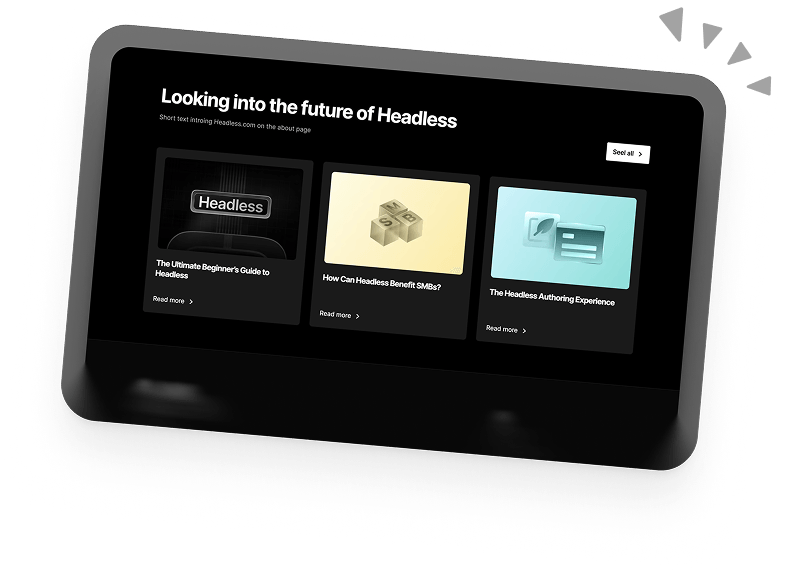10 Important B2B CX Trends to Know
We live in an “experience economy”. And yes this affects B2B businesses too.
Whether it’s B2B or B2C, people want more than just a simple transaction. We may have all adapted to the detached convenience of online business, but we still crave those personalised experiences. Customers want to feel that they are seen, heard, and valued. People will pay more for quality customer experience. For many people, CX is even more influential than advertising.
So, to summarise: fine-tuning your B2B CX should be a number one priority for your business. And to help you achieve that, I’ve put together a list of 10 of the most important trends in B2B CX that you need to implement.
And now, without further ado, let’s get started.
1. Internal alignment
B2B companies use seamless internal alignment across all departments to provide fluid customer experiences. As buyers will interact with different people and departments along their journey, each team should be aware of what the others are doing and how they have interacted with customers.
This is crucial because customers expect you to remember and understand their previous interactions with your brand, even if it was a conversation from weeks ago.
A 2022 study by Insightly involving more than 500 go-to-market professionals found that 36% of companies with fully aligned technology and customer data across their marketing, sales, and customer success teams experienced a significant increase in revenue. In contrast, only 14% of those with less alignment saw similar growth. Bottom line: alignment fuels growth.
2. Personalisation and customisation
Delivering personalised and customised experiences is now essential for B2B companies’ success. 59% of B2B decision-makers consider it vital for brands to personalise their buyer’s journey. These figures show that the majority of B2B decision-makers recognise the value of a customised buyer’s journey and are willing to invest in it.
Each of your customers and their stakeholders is unique, and their sales journey should be tailored to their goals, pain-points, and preferences. 65% of B2B buyers are likely to switch providers if they don’t receive personalised interactions. Offering a customised customer journey through preferred channels can help prevent your customers from seeking better experiences elsewhere.
3. Omnichannel Support
Gone are the days when customers could only contact businesses over the phone. Today’s customers are active on multiple platforms and expect you to be there too.
Businesses now have to engage with customers across various channels, such as website forms, mobile apps, live chat, and social media, just to name a few. Now, It’s not enough for customers to have multiple ways to reach you. They also expect consistent communication across all these channels. That’s where the idea of omnichannel comes into play.
It’s interesting to note that, according to a McKinsey study, B2B decision-makers used an average of 5 channels for their decision-making process in 2016. That number increased to 7.5 in 2019 and then jumped to 10 channels in 2021.
B2B buyers continue to use more channels than ever to make purchasing decisions. A notable example is the 250% increase in B2B mobile app ordering since before the pandemic.
To create a successful omnichannel strategy, start by analysing your target audience to determine their preferred channels. Then, ensure your sales and support teams are available on these channels to provide a seamless and consistent customer experience.
And speaking of analysing…
4. Data-driven Insights
More and more B2B companies are embracing the power of data, using it to understand their customer’s behaviour, preferences, and needs. With these insights they can create personalised experiences, anticipate customer requirements, and identify areas for improvement.
The B2B buying process is complex, and customers spend time researching and evaluating their options. According to Korn Ferry, 52% of B2B buyers experience longer buying cycles for new purchases.
Data-driven insights help businesses understand where customers are in the buying cycle so they can provide the right support at the right time.
Regularly gathering data from these stakeholders allows companies to quickly adjust their strategy, providing a personalised customer experience for each stakeholder within the B2B customer account.
5. Data security & Transparency.
Of course, while collecting all that data, you need to make sure your customers feel safe with you handling their information.
As B2B companies increasingly rely on customer data to improve their marketing and customer experience strategies, safeguarding this data and being transparent about how you use it is even more important. People are increasingly concerned about data privacy and expect businesses to handle their information responsibly.
According to a McKinsey study, 52% of B2B purchasers would turn away from a business with unclear security policies. Therefore, your company must have transparent and robust data security measures.
Let your customers know what data you’re collecting, how you use it, and why it benefits them. Being open about your data collection practices helps build trust and shows your customers that you respect their privacy. This approach lets you maintain a transparent relationship built on trust and mutual understanding.
6. Self-service Options
Self-service options are now widespread in the B2B world. Customers prefer to find answers independently rather than waiting for help. They’re all about efficiency and getting things done quickly.
According to TrustRadius, 100% of buyers, (i.e. every buyer), now want self-serve options for at least a portion of their purchasing process, marking a 13% increase since 2021.
7. AI-Enhanced Customer Service
As of 2020, Gartner estimated that only 25% of customer interactions were automated through AI and machine learning. However, with GPT-4, AI technology is becoming multi-modal and increasingly influential in business and daily life.
AI can be used in B2B customer service through:
- Customer Service Chatbots: These AI-powered solutions use natural language processing algorithms to create bots to engage customers and guide them through the buying journey.
- Self-Service Portals for Customers: AI can assist in building a knowledge base that B2B leads and customers can access when they prefer to conduct their research.
- Automated Email Communication: AI can help generate email newsletters, announcements, or responses, streamlining communication with B2B clients.
Integrating AI into customer service operations can help relieve your team’s workload, reduce customer service investment, and improve performance tracking and data collection. You can then use these insights to enhance your product and service and improve customer satisfaction.
8. Voice of the Customer (VoC) programs
VoC programs gather customer feedback and opinions to understand their needs and expectations better. By actively listening to what your customers say, you can make informed decisions that enhance your products and services, ultimately improving the overall customer experience.
So, why is this trend gaining traction? Because businesses are realising that customers hold the key to their success. By actively engaging with customers and gathering their feedback, companies can identify areas for improvement, uncover new opportunities, and stay ahead of the competition.
According to a study conducted by The Aberdeen Group, companies that prioritise customer feedback programs enjoy greater client retention and employee engagement and spend less on customer service.
Further research by Gartner found that gathering customer feedback can boost success rates for upselling and cross-selling by 15% to 20%. Additionally, the study revealed that companies actively participating in VoC programs spend 25% less on customer retention than those without such programs.
Businesses can implement a VoC program by collecting customer feedback from surveys, interviews, or even social media listening tools. Analysing this feedback, you can uncover valuable insights that can guide your business decisions and help you address customer concerns. Acting on these insights allows companies to deeply personalise and enhance customer interactions.
9. Aligning Brand Values
Companies today want to do business with brands that share their values and beliefs. Customers are increasingly concerned about social responsibility and want to engage with brands that share these priorities.
Research by Edelman shows that 63% of people are more drawn to brands that are trying to make the world a better place
This is why it’s more important than ever to be transparent about your company’s values. You can do this by:
- Sharing stories of your brand’s impact
- Promote social initiatives
- Showcase your commitment to your values on various channels and in-person events
- Engage in discussions on issues related to your values
Engaging with relevant issues can make you a thought leader in your industry. This comes with the additional benefits of making your brand more credible and authoritative. Among B2B executives, an overwhelming majority (84%) believe that thought leadership is a crucial aspect of engaging with their customers.
10. Post-Sale Customer Engagement
A business relationship doesn’t end once the sale is closed. Businesses need to continually prove their value to their clients by prioritising post-sale customer engagement.
Companies can strengthen their post-sale relationships through things like:
- Maintain contact with clients
- Ask for feedback
- Offer assistance and advice
- Offer exclusive discounts and resources
Every client is unique, and their needs will likely evolve. Stay in touch with your clients and actively seek their feedback to ensure you meet their expectations and address any concerns. They’ll feel valued and be more likely to stick around.
When you provide ongoing support and share relevant information, you’re enhancing their experience and establishing your brand as a trusted partner and building loyalty.
Bottom line
Remember, customers who have a positive experience will share it with others, which can lead to new business opportunities. Investing in B2B customer experience is more important than ever, and the trends we discussed in this article can help you stay ahead of the game.
With a solid B2B CX strategy, you can set yourself apart from the competition and build fruitful, long-lasting relationships.
Keep Exploring B2B Digital Experiences…
Some more of our B2B guides:
Book a 30-min Introduction Call
Let's jump on a quick intro call We'll break down your project, and pinpoint exactly how we can help.



Our clients  Holaa! love working with us see their stories below!
Holaa! love working with us see their stories below!






